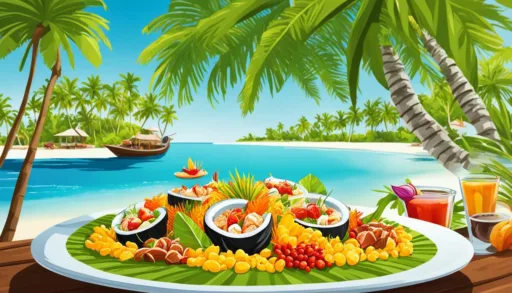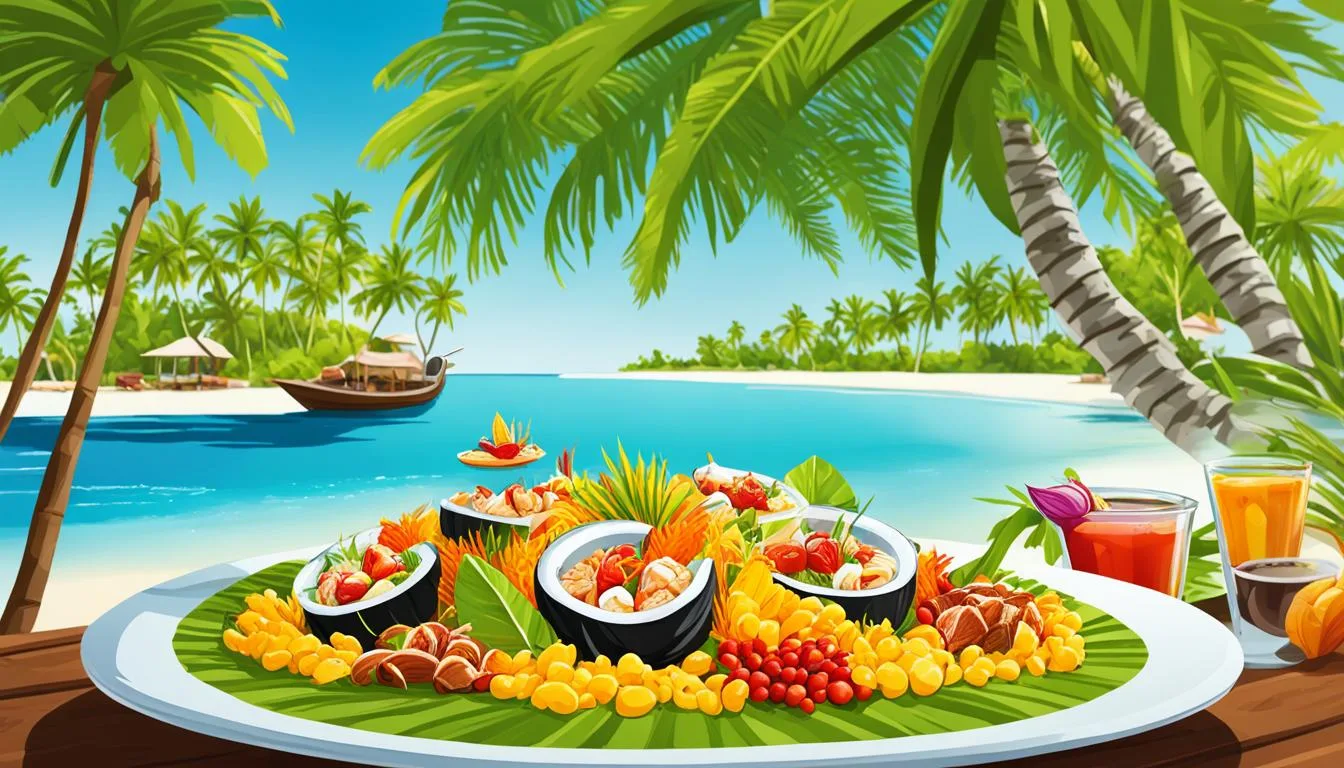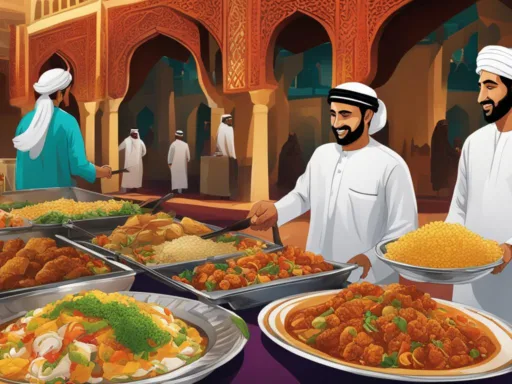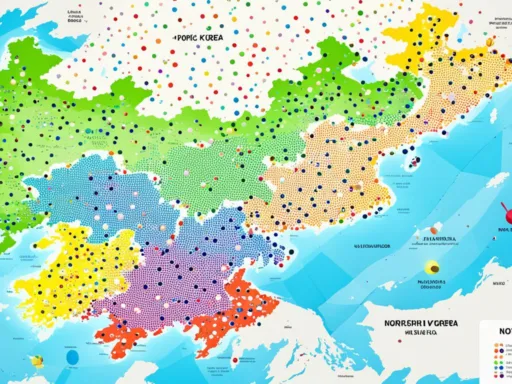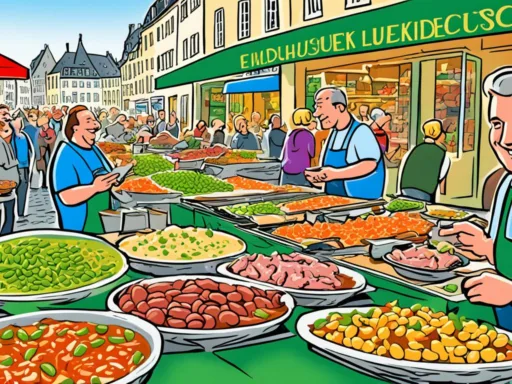When you think of the Maldives, your mind might wander to visions of pristine white-sand beaches and luxurious overwater bungalows. But beyond the breathtaking scenery lies an undiscovered treasure trove for food enthusiasts—Maldivian Cuisine Discoveries. The Maldivian food culture is an exotic mosaic, a testament to the islands’ storied past and geographical wonders. Diving into the heart of traditional Maldivian recipes, we embark on a culinary journey that unravels a plethora of flavors, techniques, and stories that have shaped the Maldives’ delectable heritage. Prepare to cast aside preconceived notions of island cuisine as we reveal the vibrant and sumptuous world of Maldivian flavors.
Key Takeaways
- Exploring the intricacies of Maldivian Cuisine Discoveries provides a new perspective on island gastronomy.
- Understanding Maldives food culture is essential for appreciating the diversity and complexity of its dishes.
- Discovering traditional Maldivian recipes opens a window into the archipelago’s multicultural influences and rich culinary history.
- A journey through Maldivian cuisine is as much a cultural exploration as it is a gastronomic adventure.
- Every dish tells a story, contributing to the unique and dynamic food narrative of the Maldives.
The Essence of Maldivian Cuisine: A Multicultural Fusion
The archipelago of the Maldives, with its crystal blue waters and white sands, has long been a destination for those seeking paradise. Yet, its culinary landscape offers its own form of escapism—a journey through multifarious flavors that celebrate the Maldives’ lengthy history as a crucial center of maritime trade. It’s here where the expressive narrative of Maldivian culinary traditions unfolds, telling stories of cultural amalgamation through every bite of Maldives local dishes.
The Historical Significance and Multicultural Influences
With waves lapping against its shores from all directions, the Maldives has been a mingling point for traders from India, Sri Lanka, and Arabia since ancient times. This convergence has weaved an intricate tapestry of tastes that grace the Maldivian table. Maldivian cooking techniques are a testament to these enduring connections, often reminiscent of the gastronomic practices from these regions, yet distinctly Maldivian in spirit and essence.
Seafood at the Heart of Maldivian Food Culture
The ocean’s bounty is central to Maldivian life, and this is profoundly reflected in their gastronomy. Fish, particularly tuna, is the star of the show, found in countless preparations, symbolizing the deep relationship between the people and the sea. From the simple grilling of fresh catch to elaborate curries that simmer in pots, seafood is the heartthrob of the islands.
Garudhiya: The Beloved Fish Soup of the Maldives
Gently bobbing in its delicious broth, the tuna in Garudhiya, a revered fish soup, comes alive with the addition of coconut and a carefully selected array of aromatic spices that fill the air with an enticing aroma. This dish isn’t just a soup; it’s a bowl of comfort that encapsulates the Maldivian soul, a proud representation of the locale’s gastronomic ideology.
Adjacent to the rooted traditions are innovations like Bis Keemiya, reminiscent of the samosa but with a Maldivian twist, showcasing the continuous evolution of the islands’ cuisine. The legacy of these recipes and the culinary methods applied is preserved with rigor by those who understand the nation’s palate and stand guard over the authenticity of its tastes. Maldivian cuisine, enriched by centuries of trade and cultural exchanges, invites both locals and travelers to its table for a truly multicultural feast.
Maldivian Cuisine Discoveries: A Gastronomic Adventure
As one embarks on a quest to unearth the Maldives authentic cuisine, they are met with a tapestry of traditions that paint a vivid portrait of the nation’s rich heritage. The tapestry of Maldivian flavors is not a mere happenstance but an artful legacy of combining locally sourced staples with refined culinary craftsmanship. To fully appreciate the diversity of dishes, one must dive into a careful exploration of the ingredients that are the cornerstone of the Maldivian culinary realm.
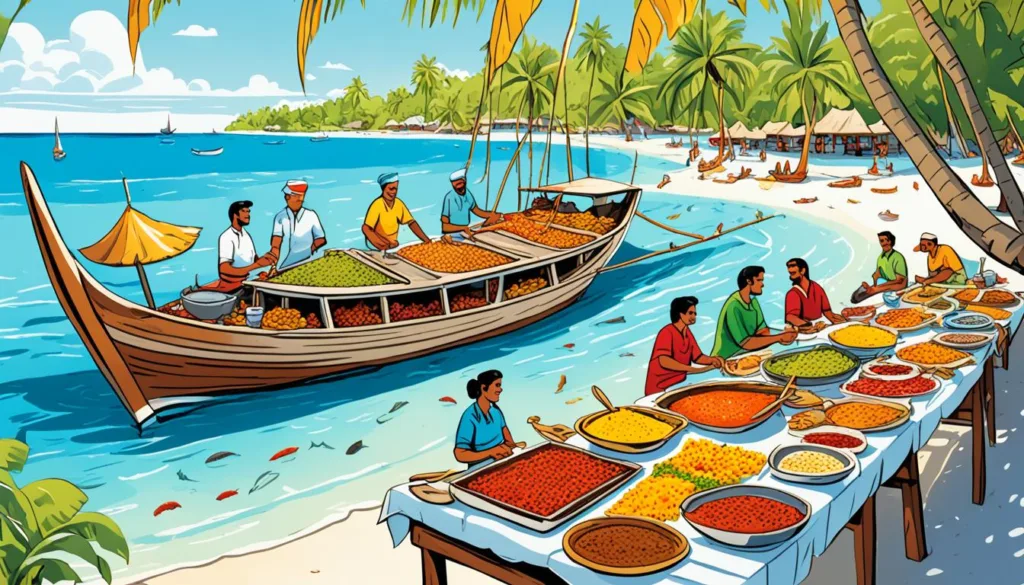
For those who seek an authentic Maldivian gastronomic experience, a variety of dishes await. From the comfort of street-side eateries to the elegance of high-end resorts, the distinctive taste of Maldivian cuisine remains a constant indulgence for both the palate and the soul.
| Dish | Ingredients | Flavor Profile |
|---|---|---|
| Garudhiya | Tuna, curry leaves, chili, garlic, coconut | Savory with a hint of spice and herbaceous notes |
| Mas Huni | Smoked tuna, coconut, onions, lemon | Refreshing combination of smoky and citrus flavors |
| Bis Keemiya | Pastry, tuna or chicken, cabbage, egg, onions | Mildly spiced with a comforting, flaky texture |
| Hedhikaa | Various, often fish, coconut, chili, lime | Bite-sized snacks offering a burst of tangy and spicy flavors |
Every bite takes you on a journey through the Maldives’ history, where each dish tells a story of the islands’ encounters with seafarers and traders from distant lands, leaving behind a legacy etched in taste.
It is this blend of histories and the ardent preservation of Maldivian cooking techniques that brings together communities, celebrating a cuisine that is as inviting as the turquoise waters surrounding the nation’s sun-kissed archipelago. Whether it is the tangy zest of a tropical fruit salad or the robust warmth of a Maldivian curry, the islands’ delicacies provide a culinary escapade unlike any other.
From Sea to Table: The Role of Seafood in Maldivian Culinary Traditions
The islands of the Maldives, surrounded by the bountiful Indian Ocean, are renowned for their exquisite seafood offerings, each a testament to the nation’s strong fishing heritage. Maldives seafood delicacies feature prominently in the local diet, where the fruits of the sea are transformed into culinary marvels through traditional Maldivian recipes. An intimate journey from catch to cuisine, these recipes embody the very essence of Maldivian life, crafting flavors that echo the whispers of the waves and the spirit of the sea.
Sea Cucumber: A Local Delicacy in Maldivian Diet
Among the array of seafood, the sea cucumber holds a place of pride. Highly regarded by food enthusiasts for its nutritional value and intriguing texture, it is a local delicacy that adorns many Maldivian dishes. When cooked, it offers a distinctive taste, enhancing the rich mosaic of Maldives seafood delicacies with its subtle yet captivating flavor.
Traditional Cooking Techniques and Fresh Catch
Respecting the age-old traditions passed down from generation to generation, Maldivian cooks use time-honored cooking techniques to accentuate the natural flavors of their fresh catches. The clear waters ensure a consistent supply of premium seafood, from robust tuna to the slender sea cucumber. Indigenous methods, including grilling over coconut husk embers and simmering in pots of richly spiced coconut milk, bring out the best in these natural gastronomic treasures, allowing for a culinary experience deeply rooted in the traditional Maldivian recipes.
The Unique Breakfast of the Maldives: A Guide to ‘Mas Huni’
Embark on a culinary morning excursion through the Maldives and uncover the wholesome delight known as Mas Huni. This traditional Maldivian breakfast is a staple across the archipelago, capturing the essence of the local lifestyle with its simplicity and flavor.
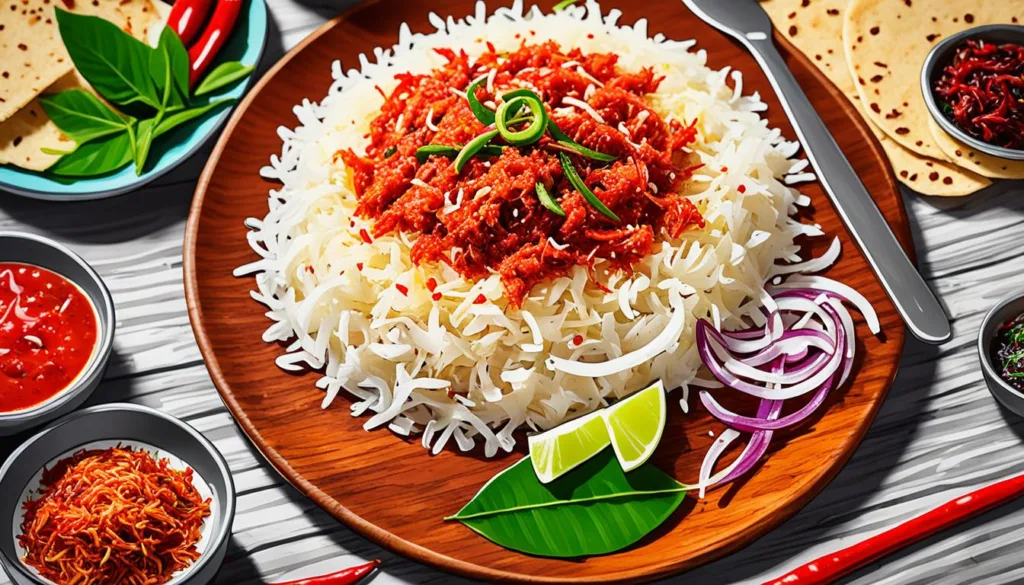
For those yearning to start their day with the authentic taste of the islands, Mas Huni is an immaculate fusion of finely chopped tuna, fresh grated coconut, onions, and a dash of chili, complemented with a squeeze of lime to elevate its refreshing zest. Each ingredient is meticulously selected to represent the bounteous Maldivian seas and the tropical gardens, creating a dish that’s light yet satiating, ideal for a day of island adventure or relaxation beside turquoise waters.
The Ingredients of a Traditional Maldivian Breakfast
Mas Huni isn’t just a dish; it’s a symphony of flavors carefully curated by the Maldivian palate. It pairs exquisitely with Roshi, the local flatbread, and a hearty cup of black tea, encapsulating the essence of Maldives local dishes in each bite. Here’s how the local delicacy lines up:
- Tuna – fresh from the Indian Ocean, often tuna is the heart of the dish, providing rich, succulent flavors.
- Grated Coconut – a versatile tropical fruit giving sweetness and a creamy texture.
- Onions and Chili – adding a kick of spice and sharpness, balancing the mild coconut.
- Lime – for a tangy freshness that ties all the flavors together.
- Roshi – the traditional Maldivian unleavened bread, providing a subtle, soft contrast to the vibrant mix.
Local Eateries for Authentic ‘Mas Huni’ Experience
Venture into the vibrant heart of Malé or the serene corners of quiet islands, and you will find the best Maldivian restaurants serving their rendition of Hedhikaa, the local term for a selection of traditional snacks, among which Mas Huni shines bright. These establishments, steeped in cultural charm, offer a welcoming atmosphere where you can savor Maldives local dishes and feel the pulse of the country’s burgeoning food scene.
Whether you’re settled in a beachside café or a bustling city eatery, the distinct flavors of Mas Huni provide an enriching start to your day, immersing you in the local customs and gastronomical heritage of the Maldives.
Exploring Maldivian Street Food: Savory Snacks and Where to Find Them
Diving into the vibrant world of Maldives food culture, one quickly discovers that the bustling streets of the archipelago are lined with savory snacks that serve as a testament to the rich Maldivian culinary traditions. For locals and travelers alike, these street eats are not just food; they’re a narrative of history and culture crafted over a hot griddle or in a steaming pot.
The Maldives may be synonymous with pristine beaches and azure waters, but walk the streets of Malé and Hulhumale, and you’re enveloped in an enticing aroma of traditional Maldivian recipes being prepared right before your eyes. Snack vendors and quaint cafes offer a plethora of options that cater to every palate, from the crispy edges of a freshly fried Bis Keemiya to the soft, comforting dough of a well-stuffed Masroshi.
These delectable bites are a celebration of local ingredients and time-honored recipes, offering a genuine taste of island life. To give you a glimpse into the repertoire of Maldivian street food delicacies and where to find them, we’ve compiled a table of must-try snacks:
| Snack | Description | Best Places to Try |
|---|---|---|
| Bis Keemiya | A savory pastry filled with tuna, hard-boiled egg, and onions. | Café Iruvai, Malé |
| Masroshi | Pastry stuffed with smoked fish and grated coconut mix. | Raaveribe Maalan, Hulhumale |
| Gulha | Small dumpling-like balls filled with smoked fish, onions, and coconut. | SeaHouse Café, Malé |
| Bajiya | The Maldivian version of a samosa, filled with fish, coconut, and onions. | Hulhumale Food Court |
To truly immerse yourself in the Maldivian food scene, venture beyond your resort and explore the streets where culinary adventure awaits. Indulging in these traditional Maldivian recipes allows you to connect with the local culture in the most delicious way possible.
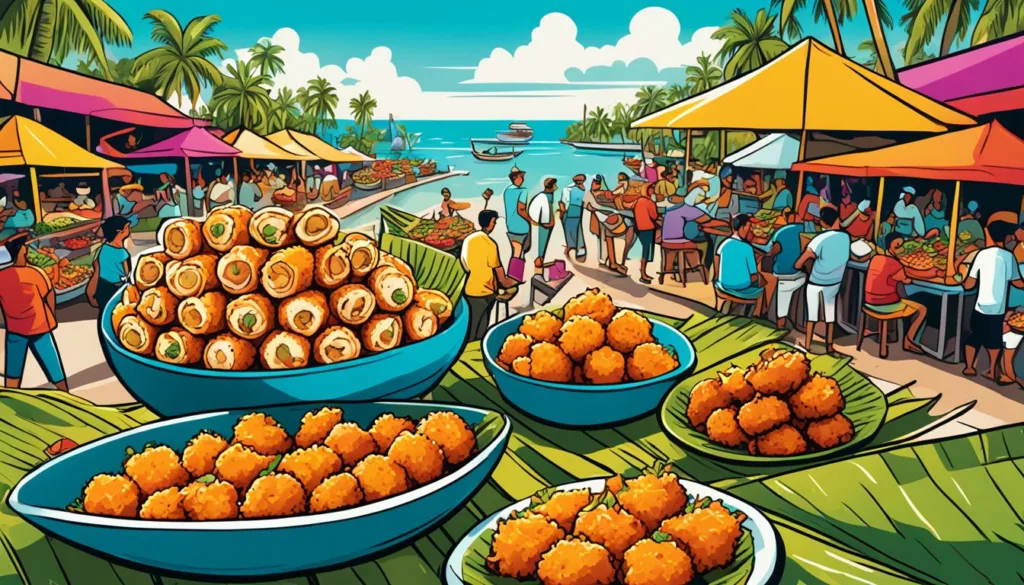
As night falls and the streets light up with the bustling energy of night markets, another aspect of Maldives food culture awakens. The air is thick with the scent of grilled fish, the sizzle of frypans, and the chatter of satisfied diners. Each bite not only satiates the hunger but also feeds the soul with the warmth of Maldivian hospitality and the enduring spirit of its people.
Maldivian street food doesn’t just cater to the taste buds; it’s an excursion into the heart of local life, serving up slices of history through every piece of hedhikaa (snack). To taste these culinary marvels is to tread a path through a lineage of flavors, a journey that’s both endlessly diverse and deeply authentic.
Aromatic Curries and Coconut Delights: The Staple Flavors of the Maldives
Immerse yourself in the rich tapestry of Maldivian flavors where the robust taste of aromatic spices seamlessly melds with the subtle sweetness of coconut milk. This culinary harmony is the essence of our island’s cuisine, captivating the palate of all who journey through our tropical escapades. By indulging in our mindful combination of indigenous spices and herbs with the lustrous versatility of coconut, one can truly appreciate the unique culinary signature of the Maldives.
Spices and Herbs Integral to Maldivian Cuisine
Maldivian spices and herbs lie at the heart of every dish, turning the ordinary into the extraordinary. Whether it’s the warmth of cumin, the pungency of cardamom, or the fragrant nuance of curry leaves, these natural treasures bring out the bold flavors and exotic character of Maldivian culinary creations.
Coconut: The Irreplaceable Ingredient in Maldivian Recipes
From creamy curries to delightful desserts, coconut-based Maldivian dishes hold a place of honor in the islands’ cuisine. Coconut, harvested from our lush palms, transforms the simplest ingredients into rich and hearty meals adored across the archipelago.
Coconut is not just a food ingredient in the Maldives; it’s a symbol of our heritage, a staple of sustenance, and a binding feature in our community’s shared meals.
Below is a table outlining some of the most beloved coconut-based Maldivian dishes, each offering a unique taste of the islands:
| Dish | Main Ingredients | Description |
|---|---|---|
| Kulhi Boakibaa | Fish, coconut, chili, and onions | Savory fish cake, balancing the heat of the chili with the creaminess of the coconut. |
| Mas Huni | Smoked tuna, shredded coconut, onion, and chili | A refreshing concoction typically served for breakfast, enjoyed with roshi flatbread. |
| Fihunu Mas | Fish, ground coconut, and spices | Grilled fish marinated with a spiced coconut paste, offering a smoky and spicy flavor. |
| Banbukeylu Hiti | Breadfruit, coconut milk, curry leaves, and spices | A thick, creamy soup that’s a testament to the versatility of breadfruit enhanced with coconut milk. |
Indeed, the Maldivian cuisine is replete with dishes that showcase the depth of flavor achieved when spices and coconut unite. It’s this distinctive taste that continues to enamor and enchant, making every meal a delicious reminder of the islands’ abundant natural gifts and cultural inheritance.
Feasting on Sea Side Delicacies: Best Maldivian Restaurants for Seafood Enthusiasts
The Maldives, an archipelago synonymous with crystal-clear waters and scenic beauty, is also a treasure trove for seafood lovers. Here, the best Maldivian restaurants lure gastronomes with their promise of fresh catches and Maldives authentic cuisine. Visitors can explore a realm where indulgent flavors meet the tranquility of the ocean.
Discovering High-End Culinary Experiences in the Maldives
Those seeking a taste of luxury will find solace in the high-end resorts of the Maldives. Each restaurant, with its own signature style, offers exquisite menus teeming with seafood delicacies that are both international in flair and local at heart.
Authentic Maldives Authentic Cuisine at Local Hangouts
For an immersive cultural experience, local hangouts are the best places to rub shoulders with the residents and dive into traditional dishes. These venues epitomize the rich tapestry of Maldivian authentic cuisine, serving timeless favorites on a backdrop of island tunes and sandy floors.
| Restaurant | Location | Specialties | Ambiance |
|---|---|---|---|
| Ithaa Undersea Restaurant | Rangali Island | Lobster and reef fish dishes | Underwater with coral garden views |
| Seagull Cafe House | Malé | Grilled seafood platters | Bustling city eatery |
| 5.8 Undersea Restaurant | Hurawalhi Island | Multi-course tasting menus | Glass-bottom, ocean immersion |
| The Crab Shack | Shaviyani Atoll | Soft-shell crabs | Relaxed beachfront dining |
Whether you choose the overwater opulence or the simplicity of a beachside grill, the Maldives makes every meal a celebrated occasion against an unforgettable oceanscape.
International Influences and Local Ingredients: Crafting the Taste of Maldives
The Maldives culinary heritage is a vibrant tapestry woven with threads of global influence and local tradition. This island nation’s cuisine has masterfully synthesized international culinary influences with its lush bounty of native ingredients, painting a palate of flavors that’s distinctively Maldivian. Where aromatic Indian spices meet the tropical allure of coconut and fresh seafood, there emerges a food story, as captivating as the azure skies and waters of the Maldives.
Historically, the Maldives stood as pivotal sea trade lanes, welcoming traders from India, Sri Lanka, Arab nations, and Southeast Asia. Such cross-cultural exchanges saw the introduction of foreign flavors that now meld seamlessly within Maldives’ own pantry. It’s a culinary dialogue that celebrates both heritage and harmony, inviting taste buds on an excursion of both familiar and enchanting aromas. This fusion is not just a matter of taste but also a reflection of the archipelago’s open embrace of varied influences, making it a unique culinary destination.
As one explores the array of dishes rooted in the Maldives, what stands out is how staple ingredients such as seafood – particularly tuna – and coconut are transformed by a confluence of spices and cooking techniques from around the world. The result is a gastronomic identity that resonates with a sense of place, anchored firmly in the sparkling lagoons and palm-fringed horizons of the islands. From succulent grilled fish marinated in a blend of spices to the velvety sweetness of coconut milk-based desserts, every dish tells a story of the island’s past and present.
Maldivian cuisine holds a mirror to the islands’ multifaceted history – a culinary journey marked by the ebb and flow of oceanic trade, the mingling of diverse cultures, and the wise utilization of what the land and sea provide.
It’s this exquisite combination of international culinary influences and local ingredients that has positioned the Maldives as a fascinating destination for food enthusiasts seeking to experience the global in the guise of the local.
The Cultural Tapestry of Maldivian Food: Communal Eating and Celebrations
At the heart of the Maldives lies a vibrant cultural scene expressed vividly through its communal eating and celebratory food customs. Maldivian cooking techniques are not simply processes of food preparation, they’re a conduit for storytelling, cultural expression, and bringing together communities during festive times. Engaging in the joyous celebrations with food, one can truly immerse themselves in the Maldivian way of life, experiencing first-hand the unity and warmth that characterize these gatherings.
Bodu Eid: A Culinary Reflection of Gratitude and Togetherness
During Bodu Eid, the end of Ramadan, the Maldivian communities gather to create a celebratory feast that reflects the gratitude and togetherness synonymous with the festival. The air fills with the aroma of creamy, spicy curries and grilled fish, as families and friends partake in time-honored recipes that have been passed down through generations, all the while infusing them with personal touches and shared laughter.
Hulhangu: Embracing the New Harvest with Traditional Feasts
Hulhangu marks the period of embracing the new harvest, with traditional feasts that pay homage to nature’s bounty. As part of the festivities, locals prepare an array of dishes showcasing the best of the harvest, from flavorful casseroles to an eclectic mix of tropical fruit based desserts, lending a celebratory mood that resonates through the island’s atmosphere.
These occasions showcase not only the diverse and delectable dishes that form the crux of Maldivian flavour but also illustrate the intricate interplay between cultural celebrations with food that has been a cornerstone of shared existence in the islands for centuries.
The communal nature of Maldivian celebrations is further illuminated in the following table, providing insight into the foods that are traditionally associated with these gatherings and the significance they hold:
| Celebration | Signature Dishes | Cultural Significance |
|---|---|---|
| Bodu Eid (Eid al-Fitr) | Rice, Garudhiya (fish soup), Roshi (flatbread), date palms | Marks the end of Ramadan with gratitude for the year’s blessings; sharing food signifies abundance and prosperity. |
| Hulhangu (New Harvest Festival) | Seasonal fruits, sweet puddings, and grilled fish | A celebration of the new harvest season; dishes made with fresh produce represent hope and good fortune for the coming year. |
Through these engagements in eating and celebrating together, the Maldivian community not only indulges in their rich culinary heritage but also fortifies the social fabric that is so essential to their island identity.
Conclusion
Embarking on a Maldives culinary journey is an experience rich in taste and steeped in culture, a voyage that delves deep into the heart of the island’s heritage. Each flavorful dish is a testament to the Maldives’ fascinating blend of influences, cultures, and natural splendor, producing lasting impressions on both locals and the global community of travelers. The archipelago’s commitment to maintaining its treasured recipes and practices ensures that its culinary identity remains unaltered, captivating the palates of curious gourmets from across the world.
The Lasting Impressions of Maldivian Culinary Journeys
The unique, savory concoctions and enchanting spice-laden aromas of Maldivian cuisine resonate long after the plates have been cleared. For countless food enthusiasts, these lasting impressions become cherished memories, emblematic of the islands’ warm hospitality and rich culinary traditions. As stories of these Maldivian gastronomic adventures are shared far and wide, they contribute profoundly to the mosaic of global food culture.
Preservation and Promotion of Maldivian Culinary Practices
The gastronomic allure of the Maldives extends far beyond its pristine beaches and crystal-clear waters. As a fundamental part of the nation’s cultural identity, there is an ongoing dedication to the promotion of Maldivian cuisine and its intricate practices. This commitment ensures that the art of traditional Maldivian cooking continues to flourish, securing its place on the global culinary stage. Advocates for this culinary heritage work tirelessly to preserve the integrity and spirit of the islands’ delectable creations, embodying the essence of Maldivian hospitality for future generations to savor.
FAQ
What are some traditional Maldivian recipes?
Traditional Maldivian recipes are heavily seafood-based due to the country’s geographic location. Some popular dishes include Garudhiya (a fish soup), Mas Huni (a tuna and coconut-based breakfast dish), Bis Keemiya (samosa-like snacks), and Kulhi Boakibaa (spicy fish cakes).
What makes Maldivian cuisine unique?
Maldivian cuisine stands out due to its use of local tropical ingredients like coconut and fish, combined with a fusion of flavors from Indian, Sri Lankan, Arabian, and Southeast Asian influences. Seafood is central to most dishes, and the use of spices and herbs adds a distinctive touch to Maldivian cooking.
Where can you find traditional Maldivian food?
You can find traditional Maldivian food in various locations ranging from the streets of Malé to serene island eateries. For an authentic taste, look out for local cafes and restaurants that specialize in Maldivian cuisine, as well as street food vendors selling quick bites like Hedhikaa.
Can you get vegetarian food in the Maldives?
Yes, the Maldives offers vegetarian options as well, although the cuisine is predominantly based on seafood. There are dishes that feature tropical fruits, vegetables, and legumes, often cooked with aromatic herbs and spices.
What kind of spices are used in Maldivian cooking?
Maldivian cuisine makes extensive use of spices and herbs such as cumin, cardamom, fennel, and curry leaves. The spices are often combined with coconut milk, yielding rich, flavorful curries and stews.
How significant is coconut in Maldivian recipes?
Coconut is an indispensable ingredient in Maldivian recipes. It is used in various forms, including grated coconut, coconut milk, and coconut oil. Coconut adds a sweet, creamy flavor to both savory and sweet dishes and is a staple in Maldivian cooking.
What seafood dishes are popular in the Maldives?
The Maldives is home to a wide range of seafood dishes due to the surrounding ocean. Popular choices include Garudhiya (tuna soup), grilled fish, and curried seafood dishes. Sea cucumber is also considered a delicacy and often features in local dishes.
Are there any food-related cultural celebrations in the Maldives?
Yes, food plays a major role in Maldivian cultural celebrations. Bodu Eid, for instance, marks the end of Ramadan with an abundance of festive dishes, while Hulhangu signifies the beginning of the New Year with traditional feasts that bring communities together.
Where can tourists experience high-end culinary experiences in the Maldives?
Tourists can enjoy high-end culinary experiences at luxury resorts throughout the Maldives. These resorts often feature world-class chefs and offer an array of international and local dishes prepared with the freshest ingredients.
How are traditional Maldivian cooking techniques preserved?
Traditional Maldivian cooking techniques are preserved through the passing down of recipes from generation to generation and through local culinary schools and establishments. Additionally, cultural initiatives and tourism help in the promotion and preservation of these traditional practices.
